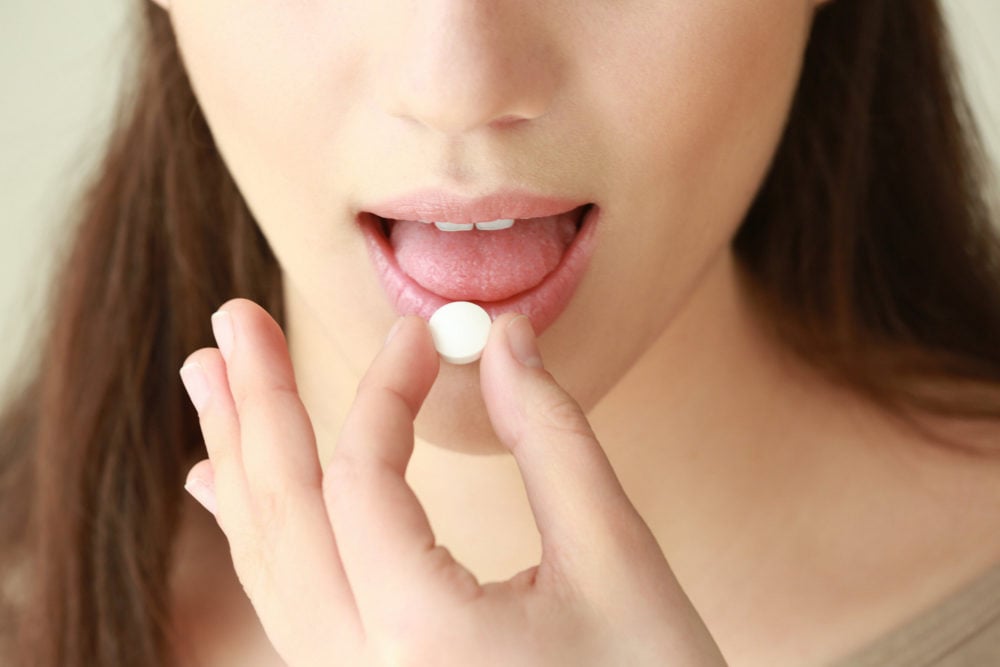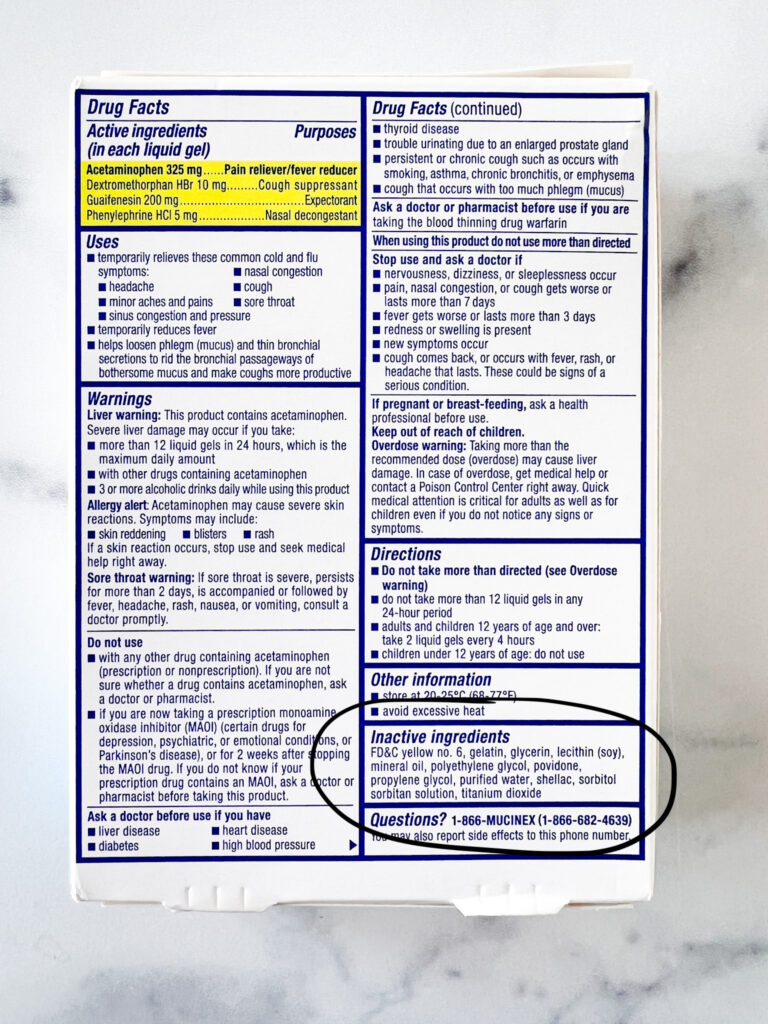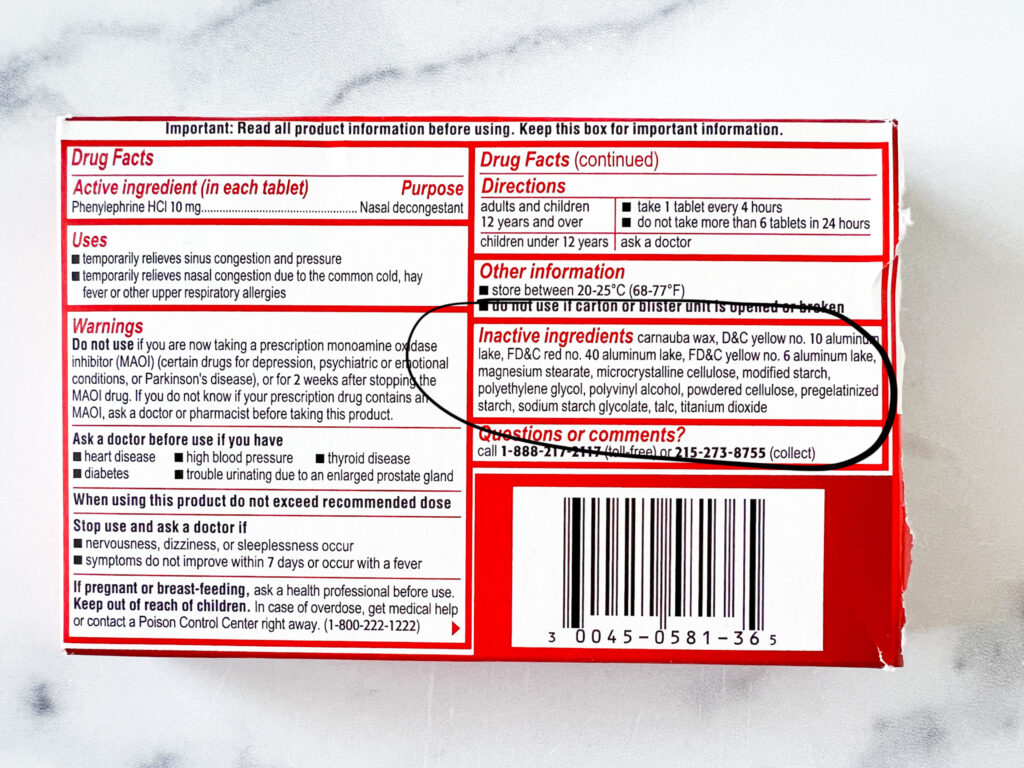
Many people in the gluten-free community wonder if there is gluten in medications. I’ll share what the FDA says about this topic and how you can protect yourself from potential gluten exposure in life-saving drugs. This post is for informational purposes and is not intended to replace medical advice from a physician or pharmacist. Please read my disclosures.
The FDA says for a food product to be considered gluten free, it must contain less than 20 parts per million (ppm) of gluten, a protein found in wheat, rye, barley, and sometimes oats, to be safe for someone with celiac disease. Celiac disease is a common genetic autoimmune disorder that affects 1 in 100 people worldwide.
While the FDA has put forth specific guidelines for food manufacturers, the FDA has not put forth guidelines for drug companies.
This means a pill meant to help you feel better might instead make you sick if you have celiac disease or gluten intolerance. It might also mean a person would forgo vital medication to avoid symptoms or complications related to potential gluten exposure.
And the gluten-free community should be concerned about gluten in medications.
A 2019 study published in Science Translational Medicine found that 18 percent of drugs contain gluten as an inactive ingredient. This means almost two out of 10 drugs contain gluten.

Gluten in Medications Resources
Several online resources may help you decipher if a specific drug is gluten free.
At one time, the National Institute of Health’s National Library of Medicine put forth a resource called Pillbox, which helped gluten-free consumers identify gluten in medications. It was a fantastic resource; however, in 2021, NIH retired the Pillbox program.
Instead, the NHI recommends the following two sources for information on gluten in medications: Medline Plus and DailyMed. Additionally, I have found a website called Gluten Free Drugs to be a semi-helpful source.
I found Medline Plus to be worthless in helping to determine if a drug contains gluten. It doesn’t even include a list of active and inactive ingredients in each pill.
The DailyMed searchable database, however, offers some helpful information. You can search for a drug by name, such as Advil, and it will list the active and inactive ingredients. The database does not tell you if the medication contains any gluten or other allergens. It only shares a list of ingredients you’ll need to decode for gluten.
A website called Gluten Free Drugs is a bit more helpful, albeit incomplete. It’s a basic website that contains an alphabetical list of drugs that notes whether the drug is:
- Gluten free.
- Unlikely to contain gluten because the manufacturer doesn’t knowingly add gluten but doesn’t do any final testing to ensure it’s gluten free.
- Contains maltodextrin, which occasionally is derived from a wheat source, although it has been deemed safe for persons with celiac disease.
- Is not gluten free.
- According to the manufacturer, it is not gluten free; however, the stated source of gluten is a sugar alcohol/polyol, which is considered gluten free by most experts and generally safe to take.
The site is helpful; however, it’s incomplete. For example, the only drug I take regularly is Zyrtec, which is not included on this list.
The FDA’s Guidelines on Gluten in Medications
While the FDA doesn’t mandate pharmaceuticals to disclose food allergens in drugs, it offers guidance for manufacturers who want to provide such information voluntarily.
In a 2017 report titled, Gluten in Drug Products and Associated Labeling Recommendations Guidance for Industry, the FDA says most medications don’t contain gluten (wheat, rye, or barley). If any do, it’s a trace amount that the FDA says is “safe” for someone with celiac disease to ingest. The FDA adds that barley and rye are used “rarely or not at all” in the production of medications.
The FDA adds, “The amount of gluten potentially present in a unit dose of an oral drug product is less than the amount of gluten that could potentially be found in a single serving of a cookie labeled gluten free in accordance with FDA’s regulations.”
Based on this information, the FDA concludes, “Individuals who respond well to a gluten-free diet are at low risk of experiencing problems as a result of the possible presence of gluten in a drug product.”
While the FDA report sounds lovely, what about that 2019 study that says 18 percent of medications contain gluten? The study’s findings are quite contradictory to the FDA’s findings.
It’s no wonder that research found that celiac disease patients worry about gluten exposure in medications, finding that 38 percent reported having an adverse reaction to gluten in their medicines.
The FDA is making strides in encouraging the disclosure of gluten in medications (inclusive of oral drugs and topical medicines applied in or around the mouth). Still, the agency’s voluntary guidelines haven’t gone far enough to protect the gluten-free community.
Gluten in Medicine Disclosure Act of 2021
Congress has introduced the Gluten in Medicine Disclosure Act of 2021, a bill that, if passed, would “prohibit the sale of any drug intended for human use that contains an ingredient derived from a gluten-containing grain unless the drug’s label (1) states that the drug contains such an ingredient, and (2) identifies the type of grain from which the ingredient is derived.”
The bill has been introduced in the House and is sponsored by Representative Tim Ryan of Ohio (D) and Representative Tim Cole of Oklahoma (R). If passed, this bill would continue to the Senate for review.
The Celiac Disease Foundation has set up an easy way for the gluten-free community to connect with their local Representatives to urge them to co-sponsor this important piece of legislation.
How To Protect Yourself?
No doubt, labeling for gluten in the pharmaceutical world has come a long way, but it has an even longer way to go. These baby steps by the FDA are, simply put, baby steps and not enough.
If you need to take an over-the-counter or prescription drug now, do the following to make sure you’re not inadvertently exposing yourself to gluten:
(1) Inspect the Label
While the FDA says it’s rare that a medication would contain gluten (wheat, rye, or barley), it’s more likely if a pill contains gluten, it would be in something derived from wheat.
This is why it’s essential to scrutinize labels and review the active and inactive ingredients. If a pill contains gluten, it will likely be listed as an inactive ingredient or excipient, an ingredient that binds the pill together. The FDA says the following ingredients could come from a gluten source, albeit rare:
- Modified starch
- Pregelatinized starches
- Sodium starch glycolate
- Hydrolysates, which include maltodextrin, dextrates, dextrose, maltose, and sugar alcohols such as sorbitol, xylitol, maltitol, and mannitol
- Any ingredient that contains the word “starch”

Also, wheat germ is often used in products applied topically to the lips or skin (sunscreen). The FDA says if Vitamin E is highly refined, it won’t contain detectable levels of gluten. If it’s not highly refined, the FDA says, “the presence of any gluten in a product applied topically to the lips would be very low, and any oral ingestion of gluten associated with the product would be insignificant.”
(2) Ask the Pharmacist
While most pharmacists are in the dark about gluten in medications, it’s good to have a conversation with them to see if they might know. They might have access to additional sources of information.
And perhaps, if enough people ask about allergens and gluten in medications, they can help champion ingredient transparency in the industry and even help advocate for the passing of the Gluten in Medicine Disclosure Act of 2021.
(3) Check GlutenFreeDrugs.com
If the ingredient list is missing on a drug label, search for the name of that drug on Gluten Free Drugs.
(4) Contact the Manufacturer
You may be surprised that you will receive a clear-cut response when you contact drug manufacturers. This is why we must keep asking drug manufacturers about gluten in medications. The more they’re asked, the more they’ll be interested in including this information on their labels and websites.
When I wrote my Is Your Lip Balm Gluten Free? article, I asked companies like Carmex and Blistex if their products contained gluten. I received quick responses and clear-cut answers.
However, you might also receive wishy-washy information from some major drug companies.
For example, after someone posted in my Gluten-Free Support Group on Facebook that some Benadryl over-the-counter medications are not gluten free, I wanted to verify this information independently.
I contacted Johnson & Johnson and received the most disappointing reply. They said, “Sadly, we do not have any information on whether our BENADRYL® Allergy Tablets have gluten or not.”
I was shocked that Johnson and Johnson, a multi-billion dollar company, doesn’t know what ingredients are in (or not in) their products.
You might also get responses like, “Our product does not contain gluten ingredients, but we cannot guarantee the product is gluten free.”
That’s like saying, “We think our products don’t contain pieces of glass, but we can’t guarantee it doesn’t.” Touche!
The important thing is that the gluten-free community continues to ask these questions of drug manufacturers. The more we ask, the more likely they will be in proactively labeling their drugs. At least, that is the hope!
(5) Research Online
The Internet can be an excellent place for crowdsourcing information; however, not everything you read or see is accurate or truthful. Reader beware.
That said, asking others in the gluten-free community to share their experiences and research can be helpful and guide you in your quest to seek accurate information.
Here are a few articles I found helpful:
- Gluten-Free Allergy and Sinus Medications
- Gluten-Free Pain Relievers List
- Gluten-Free Cough, Cold, and Flu Medicine
- Gluten-Free Cough Drops
- Gluten-Free Medications for Diarrhea, Constipation, and Heartburn
(6) Test It [Maybe]
The Nima Sensor is a portable gluten-detecting device that enables a person to test a piece of their food for hidden gluten. Unfortunately, the device is not approved for the testing of drugs. You can test a pill for hidden gluten with Nima if you want to go rogue. I tested Zyrtec for gluten anyway. I needed to know.
(7) Be a Champion for Change
While the best prescription is living well, eating right, stressing less, exercising daily, taking care of your body, and prioritizing health at all costs, few people, if any, can avoid medications their entire life. Drugs can be life-saving tools.
Contact your congressperson to co-sponsor the Gluten in Medicine Disclosure Act of 2021. If enough of the gluten-free community speaks out, congress will have no choice but to listen!
Leave a Comment